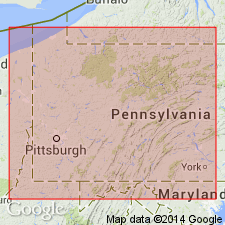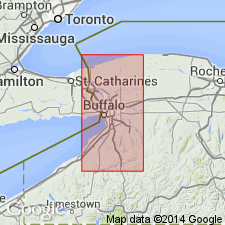
- Usage in publication:
-
- Cobleskill Limestone
- Modifications:
-
- Revised
- Areal extent
- AAPG geologic province:
-
- Appalachian basin
Summary:
Cobleskill Limestone extended into Warren Co., northwestern PA where it is assigned to Bass islands Group. Underlies Bois Blanc Formation (Lower Devonian); overlies Bertie Dolomite of Bass Islands Group (Upper Silurian). Age is Late Silurian.
Source: GNU records (USGS DDS-6; Reston GNULEX).

- Usage in publication:
-
- Cobleskill Formation
- Modifications:
-
- Revised
- Dominant lithology:
-
- Limestone
- Dolostone
- AAPG geologic province:
-
- Appalachian basin
Summary:
Bertie Group redefined. Author includes the Akron-Cobleskill interval and the newly named Moran Corner Waterlime in his revised Bertie Group. Term Rondout Formation or Group is restricted to its type area in southeastern NY. In this report, Bertie Group in western NY is subdivided into (ascending) Fort Hill Waterlime, Oatka Formation, Fiddlers Green Formation, Scajaquada Formation, Williamsville Formation, Cobleskill Formation, and Moran Corner Waterlime. Akron-Cobleskill sequence described as poorly fossiliferous, massive mottled dolostone. No eurypterids are known from the Cobleskill of western NY and the Niagara Peninsula, CAN, but as eastward facies changes occur, eurypterid-bearing limestone and dolostone are encountered.
Source: GNU records (USGS DDS-6; Reston GNULEX).
For more information, please contact Nancy Stamm, Geologic Names Committee Secretary.
Asterisk (*) indicates published by U.S. Geological Survey authors.
"No current usage" (†) implies that a name has been abandoned or has fallen into disuse. Former usage and, if known, replacement name given in parentheses ( ).
Slash (/) indicates name conflicts with nomenclatural guidelines (CSN, 1933; ACSN, 1961, 1970; NACSN, 1983, 2005, 2021). May be explained within brackets ([ ]).

